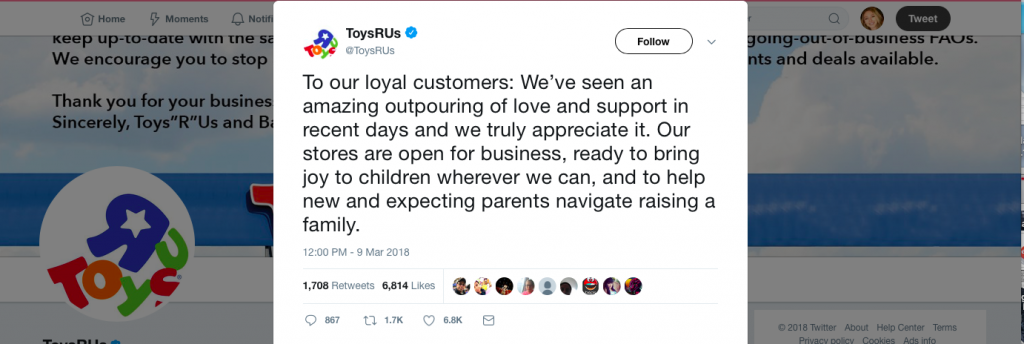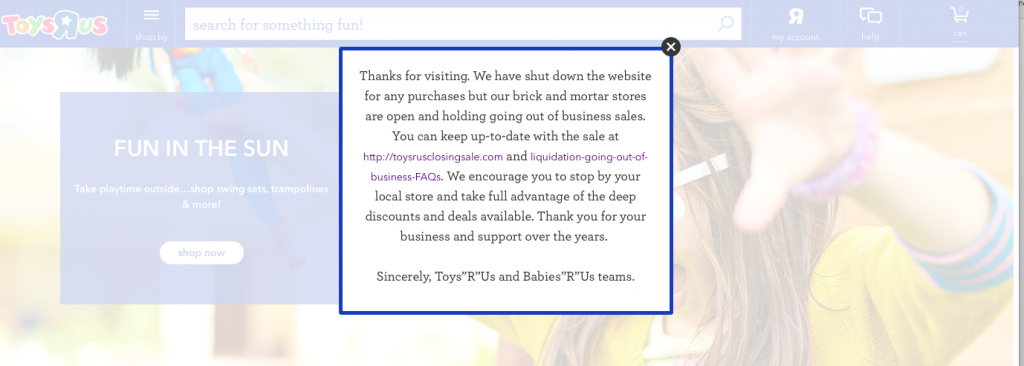I recently wrote an article for Entrepreneur almost presciently predicting “Why a Turnaround at Toys R Us Will Tank.”
The sad truth is, Toys R Us is closing its doors after 70 years in business.

Many other brick and mortar stores have been able to create successful omnichannel experiences for consumers, yet Toys R Us has always struggled. Why?
Because Toys R Us got lost in transformation.
Transforming marketing has become the priority as traditional marketing methods are no longer effective. For a company to be successful, it needs three crucial qualities in place:
- A simple, clear and aligned story where the shopper is the hero
- The right strategy that delivers remarkable shopping experiences
- The right systems in place to enable seamless engagement with ruthless consistency
Toys R Us is not failing because people stopped buying toys. According to the National Retail Federation, U.S. holiday sales grew 4 percent to $658.3 billion last year and is expected to grow 6 percent more this coming year. The fact is, people are still buying toys, they’re just not buying them with Toys R Us. Toys R Us is failing because of the misalignment of their 3S’s—Story, Strategy, and Systems, in that order.
Kelly O’Keefe, a professor of brand management at Virginia Commonwealth University nailed it when she said, “We know that customers are willing to pay more for an enjoyable experience — just look at the lines at Starbucks every day — but Toys R Us has failed to give us anything special or unique.”
Toys R Us has always been positioned as the “toy authority” for parents and children alike. The brand story was about quality, value, selection, and an in-store shopping experience focused on making the shopper the “hero.” Today, however, no one wants to be in a Toys R Us during a holiday.
Back in early 2014, Toys R Us announced its “TRU Transformation” strategy to address shopper experience challenges and position the company for growth. The problem, however, is that most people today are “hybrid” shoppers, using both online and physical retail locations as part of their buying journey, and Toys R Us wasn’t cutting it with their hybrid experience.
The company filed Chapter 11 last September, and then made the decision (after a disappointing holiday season) to shut down operations.
Toys R Us has admitted that it fell behind on its e-commerce systems. As they tried to revamp, with nearly $100 million invested over the last three years toward jump-starting an online experience, it acknowledged that it could not catch up to its retail peers.
And only two weeks after announcing it would be closing all of its stores, Toys R Us has officially shut down its website for purchases.

What can we learn from the sad demise Toys R Us?
Toys R Us failed its digital transformation. When times are changing, it’s imperative to understand how to adapt and transform within your company. Toys R Us is a perfect example of a company that continued to be stuck in the same way of doing things until it was way too late. Companies that are staying successful today are recognizing the changing marketing landscape, accepting change and accelerating on that change.
Learn more about how you can improve the transformational powers of your marketing department to drive organization-wide change by downloading our free 3S Playbook here.
Want to hear stories of how marketing and executive teams have overcome (and also how they’ve not overcome) transformation? Preview my new book Marketing, Interrupted. You can order it here.